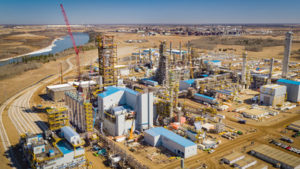Highlights
- Deficit up significantly from Budget 2020 due to COVID-19 and oil price drop but lower that first quarter forecast due to rising oil prices in final fiscal quarter (January-March 2021).
- Government takes a $1.3-billion write-down of its investment in TC Energy’s Keystone XL pipeline.
- Education spending significantly lower than budget (4 %) and from last year (4.9 %).
- Total revenues were $6.8-billion lower than budget while federal transfers $1.5-billion higher than last year.
- Dark spots- government investments- Keystone XL, oil-by-rail contracts, and the Sturgeon refinery.
 Finance Minister Toews released the Province’s annual financial report on Wednesday 30 June. In his press release he emphasized the “notable fiscal gains made in (the) final months of 2020-21.” It was an upbeat message given to inspire confidence in the provincial government’s handling of the COVID-19 pandemic and future economic prospects. The Ministry release touted the economic growth forecasts of several banks and the Conference Board that Alberta’s growth will lead all provinces. His message concerning the government’s spending approach was double edged- largesse to help the business community recover from COVID with more public infrastructure spending while acting responsibly to reduce the cost of basic government services to the levels of other large provinces. Conspicuous by its absence in the news release was the $1.3 billion write-down of the UCP government’s investment in the TC Energy Keystone XL project.
Finance Minister Toews released the Province’s annual financial report on Wednesday 30 June. In his press release he emphasized the “notable fiscal gains made in (the) final months of 2020-21.” It was an upbeat message given to inspire confidence in the provincial government’s handling of the COVID-19 pandemic and future economic prospects. The Ministry release touted the economic growth forecasts of several banks and the Conference Board that Alberta’s growth will lead all provinces. His message concerning the government’s spending approach was double edged- largesse to help the business community recover from COVID with more public infrastructure spending while acting responsibly to reduce the cost of basic government services to the levels of other large provinces. Conspicuous by its absence in the news release was the $1.3 billion write-down of the UCP government’s investment in the TC Energy Keystone XL project.
In his press conference, Toews hedged when asked about a path towards balance and dodged a question about the Parliamentary Budget Officer’s report that Alberta’s fiscal structure is no longer sustainable. He restated a pledge to look at the revenue side at an undefined time, and possibly to announce a panel before the next election. Kelley Cryderman of The Globe and Mail asked Toews about the wisdom of the Keystone XL investment and continuing losses of on railway contracts and the Sturgeon Refinery. He replied stressing proper structuring of contracts and the role of the Alberta government in supporting projects with great economic potential, including revenues to the government.
Spending
Several themes become evident. The first is the government’s desire to grind cost savings out of the Education portfolio, and in particular, the universities and colleges. In 2020-21 post secondary institutions spent $5.43- billion a drop of $459 million from the previous year’s restated numbers. The Ministry’s direct expenses actually rose by nearly $100-million with Student Aid, support for Adult Learning, and Apprenticeship Delivery going up. Of the nearly $3-billion in the Ministry’s annual revenue last fiscal year-slightly more than one-fifth was provided by the federal government, an increase of $60-million while the provincial grant fell by nearly $50-million.

Unfortunately, the Advanced Education Ministry’s financial report does not contain the individual financial statements of the 21 post-secondary institutions, so it is more difficult to see was how much the government operating grant was cut, or raised by each institution. The UofA still does not have their financial statements on their website (9 July 2021), but the University of Calgary does. Calgary’s operating grant was cut by $25-million or less than five per cent. NAIT and SAIT’s year end are June. In the case of SAIT for example it’s 2019-20 grant was cut about $25-million or by 8 per cent.
The Department of Education’s budget instruction grants declined by $161 from the previous year but also $361-million from budget. The explanation for the drop in total education spending:
Total education expense was $14.1-billion in 2020-21, $0.8 billion lower than it was in 2019-20 and $0.6 billion from Budget 2020….The decrease from 2019-20 reflects lower requirements for post-secondary institution operations, shifts to on-line classes in K-12 system, and lower K-12 student enrolments due to the COVID-19 pandemic (p. 9).
As with Advanced Education, Alberta Education received an extra $175-million over budget and last year’s figures from the federal government. Illustrating the UCP’s commitment to charter schools, this segment received a $31-million boost.
Social Services was another major ministry which saw significant reductions of $0.3-billion or about five per cent. This reduction is courtesy of Ottawa’s spending on income supports during the pandemic. Federal and other government grants to the Ministry totaled $130-million up from $6-million the previous year. Employment and Income Support spending fell $240 million from 2019-20 and $$170-million from Budget 2020. Homeless and Outreach Services rose by $25-million or slightly more than 10 per cent from the previous year and 20 per cent over the budget allocated in 2020-21.
While spending on people in education and social services was cut, this was not the case for spending on Agriculture, resource management and economic development which grew by about 16 per cent. Crude-by-rail added another $443-million in expenses. The financial summary also noted that “Other expense” was $1-billion than the previous year due mainly to the Small and Medium Enterprise Relaunch which supported businesses required to temporarily close. This program was over-expended by $39.5-million clocking over the authorized legislative vote.
As for the Health Department, the total expense was more than $1.6-billion than the previous year- hardly a surprise. The overage was less than 10 per cent of the Health budget. Physicians’ fee-for-service payments fell by$0.4-billion. Oddly, revenue from the federal government, grew by only $270-million to $6.1-billion, less than one would think given the federal government spending to help provincial governments deal with COVID. Separately identified COVID-19 pandemic expenses totaled were $1.5-billion up from a “budgeted” $500-million amount. This amount was evidently retroactively “budgeted” by the government whose February 28, 2020 budget was presented before the WHO declared the pandemic.
Revenue
Government revenue dropped significantly to $43.1 billion, $3.1 billion lower than in 2019-20, and a decrease of $6.9 billion from Budget 2020. This was due primarily to lower economic activity and more than $2.5-billion foregone with deferrals on utility bills, education property taxes, student loans, and government fees and taxes of . Personal income tax fell by $1.3-billion and corporate income tax fell by $1.1-billion. Non-renewable resource revenue fell $2.8-billion from the previous year with the WTI metric down $12.53 on average from the previous year even with a lower price differential. Federal transfers topped out at $10.5-billion a $1.4-billion increase over the previous year and the February 2020 budget. Government business enterprise (GBE)net income was a negative $83 million. While ATB’s net income was positive, the controversial TC Energy investment of $1.3 billion was provided for, another half-billion foregone from the  APMC Sturgeon Refinery boon-doggle, and a $200-million diminution from the Balancing Pool eroded the GBE category. But that not all – the government’s vice squad of cannabis, liquor and gambling returned $500 million less in revenue. Other revenue came in a bit lower than budget.
APMC Sturgeon Refinery boon-doggle, and a $200-million diminution from the Balancing Pool eroded the GBE category. But that not all – the government’s vice squad of cannabis, liquor and gambling returned $500 million less in revenue. Other revenue came in a bit lower than budget.
Footnotes
Although reading footnotes of financial statements is generally perceived as a pastime for losers, Alberta’s financial statements rarely disappoint. Note 4 reveals a restatement on contractual rights under the Canada Infrastructure Program. The restatement shows that in 2020 the audited financial statements underestimated that the provincial government the $2-billion value of its investments in the Canada Infrastructure Program- further largesse from Ottawa. In Note 6- Contractual Obligations and Commitments, there is disclosure about the Petrochemical Diversification Program (PDP) to expand Alberta petrochemical facilities.

The program initially brought forward by the NDP to add value to natural gas is described thus.
by providing a commitment of up to $1.6 billion (2020: $1.6 billion) in incentives through royalty credits, of which $650 million (2020: $650 million) has been allocated to four (2020: four) projects. As at March 31, 2021, no royalty credits have been awarded as none of the PDP projects have reached commercialization (emphasis added).
This will change as the petrochemical project underway by Inter Pipeline in the Industrial Heartland will enter production within the next year.
Note 7 or Contingent Liabilities describes a loan guarantee of $93-million by the provincial government “in favour of ATB Financial as agent and other secured creditors” to enable a consortium of six Alberta Frist Nations’ participation in the Cascade Power Project.” Should the First Nations’ group default, the creditor group led by ATB, an agent of the Alberta Crown, will have recourse to the provincial treasury. Under the same tab, legal actions against the Alberta government by First Nations total $105- billion, up from $84-billion last year. The claims relate to “treaty land entitlement for which the Province may have an obligation under the natural Resources Transfer Agreement, the 1930 agreement which granted Alberta natural resource ownership
All in all, the Province’s finances deteriorated significantly during the period of COVID-19 and depressed oil and natural gas prices. The red ink would have been much worse if it weren’t for the federal government’s contributions in many areas including the $1-billion for oil well clean up. Minister Toews’ chose to sound a positive note about Alberta’s fiscal future. With WTI trading around $75 U.S. and natural gas at $3.70 U.S.it is still is too soon to break out the champagne. This is decidedly good news for the UCP government and Alberta’s oilpatch. These prices will mean stronger cash flows to the industry and the government’s coffers. It does not mean big investments in Alberta’s oil patch, the reliable staple of Alberta politicians for two generations. The recent pivot of the European Central Bank into taking climate change seriously is but one further example that elephant projects, with lucrative contracts to construction companies and oil servicing firms, are vanishing. In spite of the good start, Alberta’s fiscal sustainability remains doubtful.
Related Posts